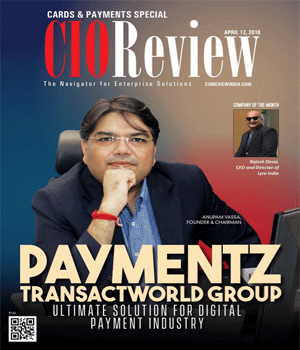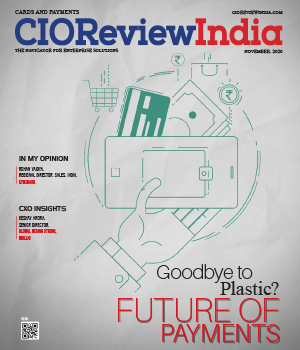
A 10,000 Feet Overview Of Blockchain
Pritam Pal, Practice Head - DevOps & Cloud Solutions at TechAspect Solutions | Tuesday, 10 July 2018, 10:12 IST
 Blockchain Fundamentals
Blockchain Fundamentals
Two decades ago, the only imaginable way of getting information was newspapers and television news channels. Finance was completely managed and controlled by banks. Everything was centralized.
With the advent of Decentralized Technologies, information became free flowing and transactions became faster. Hailing a cab made way for instant one-click digital bookings. Reserving a room made way for on-the-fly app-based bookings. Now, we are heading towards Distributed Technology where no centralized or decentralized entity retains complete ownership. It’s called Peer to Value Exchange.
Blockchain gives you the power to carry out any monetary transaction digitally via a unique ‘hash address’ without being dependent on central or decentralized institutions like banks. Blockchain applications run on the distributed database.
Blockchain database isn’t stored in any single location, which means that the records it keeps are truly public and easily verifiable. No centralized version of this information exists for a hacker to corrupt. Hosted by millions of computers simultaneously, the data is accessible to anyone on the internet.
It allows you to transact anything from a share certificate to transferring ownership of your car or house. Virtually anything of value can be tracked and traded on Blockchain network. Every agreement, every process, every task, and every payment in the world would have a digital record and signature that can be identified, validated, stored, and shared.
Individuals, organizations, machines, and algorithms would freely transact and interact with one another with little friction. This is the immense potential of Blockchain.
“Individuals, organizations, machines, and algorithms would freely transact and interact with one another with little friction. This is the immense potential of Blockchain”
History
The first work on a cryptographically secured chain of blocks was described in 1991 by Stuart Haber and W. Scott Stornetta.
For a long time, nothing happened. There was no real implementation until 2008 when the first distributed Blockchain was conceptualized by Satoshi Nakamoto in 2008. This was called ‘The Bitcoin’.
The Bitcoin design has been the inspiration for other applications. If you read Satoshi Nakamoto's original paper in October 2008, the words block and chain were used separately. When the term moved into wider use it became a single word - Blockchain.
In 2014, ‘Blockchain 2.0’ emerged, enabling users to write more sophisticated smart contracts. In early 2017, the Harvard Business Review suggested that blockchain is a foundational technology and thus "has the potential to create new foundations for our economic and social systems.”
Bitcoin
Bitcoin is one among the thousands of applications built on Blockchain technology and it’s clearly the most famous one. Bitcoin started the Cryptocurrency momentum. From $0.003/ BTC, it has grown to over $8100 as I write this. The market capitalization of Bitcoin has exceeded $70 billion. The technology underlying cryptocurrencies, which is Blockchain is said to have powerful applications in various sectors ranging from healthcare to shipping. Corporates are making investments in cryptocurrency as it’s expected that in future all FIET currencies would become obsolete.
The number of Bitcoins is limited at 21 Million. Of these, over 15 Million is mined, which supports the claim that it’s more stable than government-backed currencies that can be devalued by central banks printing money.
While paying with bitcoin would take more time to become mainstream, its transaction fees make it very attractive. While companies like Visa, Amex, and Paypal charge 6-7% fees, with Bitcoin payments one can leverage the same facility with as low as 0.5%.
You can open a Blockchain-based wallet like Coinbase and by using your bank account, store and sell Bitcoins from there.
How it Works
1. Transaction: Two parties A &B decide to exchange a unit of value. It can be a digital currency, digital representation of some asset, like share certificate, birth certificate, degree details, tax information or a lead generation report, and a transaction is initiated.
2. Block: The transaction is packed with other pending transactions thereby creating a ‘Block’. The Block is then sent to Blockchain System's network of participating computers.
3. Verification: The participating computers (Whom we call miners in Bitcoin Blockchain) evaluate the transaction and through complex mathematical calculation determine if they are valid, based on agreed-upon rules and algorithms. When 51% participating computers say Yes, the transaction is considered valid.
4. Hash: Each verified block of transactions is time stamped with a cryptographic hash. And each block contains a reference to previous block's hash thus creating a chain of records which can’t be falsified except by convincing the participating computers that the tempered data in one block and all prior blocks is true. Such a feat is considered impossible.
5. Execution: The unit of value moves from the account of party A to the account of party B.
Advantages of Blockchain Technology
Transparency and Immutability: Any changes made on the Blockchain ledger are viewable by the public, creating transparency. Altering these changes will require a huge amount of computing power to override the whole network thus making it immutable.
No Third-party Needed: Two parties are able to make an exchange without the intermediation of a third party, strongly reducing or even eliminating counterparty risk.
Data Quality: Blockchain data is complete, consistent, timely, accurate, and widely available.
Built-in Robustness: Similar to the robustness of the internet, the Blockchain is not controlled by a single entity and has no single point of failure, making it more durable to malicious attacks.
Fast Transactions and Low Fees: In comparison to interbank transactions which can take days, transactions on the Blockchain could occur within minutes. Also, in the absence of third parties, transaction costs are much lower due to the removal of overhead costs involved in facilitating transactions.
Disadvantages of Blockchain
Technology
The implications of Blockchain being utilized in the digital marketing industry make it seem like a panacea for some of the despairs and pervasive issues in the online advertising ecosystem, however, the Blockchain solutions discussed do have their limitations.
Cultural Adoption: Blockchain represents a complete shift from the established financial and commerce model. It will require both users and operators to invest in the system.
Teething Problems: Resolving challenges like consistent transaction speed, verification process, and data limits will be crucial in making Blockchain widely applicable.
Regulations: Regulatory entities usually lag behind technological innovation. Currently, there are no regulations on how the transactions should be written. This could create a hurdle in the widespread adoption of Bitcoin and Blockchain in highly regulated industries and governments where the regulation status remains unsettled.
Large Energy Consumption: Blockchain miners are attempting 450 thousand trillion solutions per second in efforts to validate transactions, using substantial amounts of computer power, which is not sustainable in the long run.
With Bitcoins crossing the $10,000 mark and tons of Blockchain based applications coming up with Initial Coin Offerings, Blockchain is poised for a long future and in next 10 years, every other business will be touched by it.
We would be coming up with more detailed blogs on ‘Ethereum’ and on ‘How to make your own BlockChain Apps or Smart Contracts’. Stay tuned and stay distributed!
CIO Viewpoint
Understanding Digital Transformation As Not...
By Mani Mulki, CIO at Tata Capital
Managing a Reluctant User Base
By Vic Peterson, CIO, Stinson Leonard Street LLP
E-Mandates and their Power to Transform Payment...
By Arif Khan, Chief Innovation Officer, Razorpay
CXO Insights
Innovation Is The Key Factor For Fintech To...
By Manish Bhatia, President - Technology, Analytics and Capabilities at Lendingkart
Emotional Intelligence And Customer Retention:...
By Keshav Arora, Senior Director, Global Design Studio, Brillio
A 10,000 Feet Overview Of Blockchain








